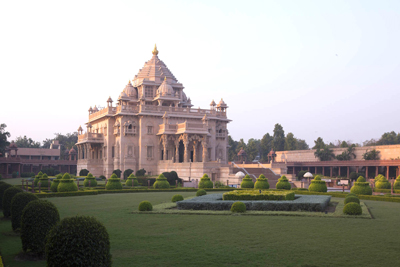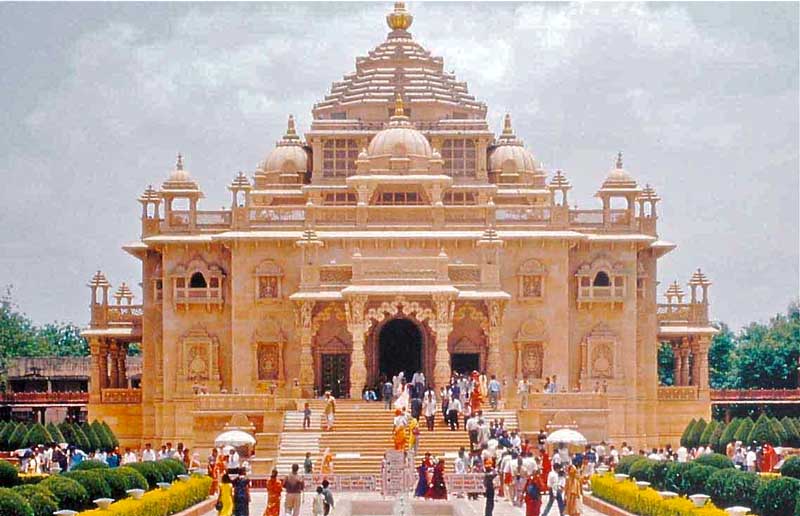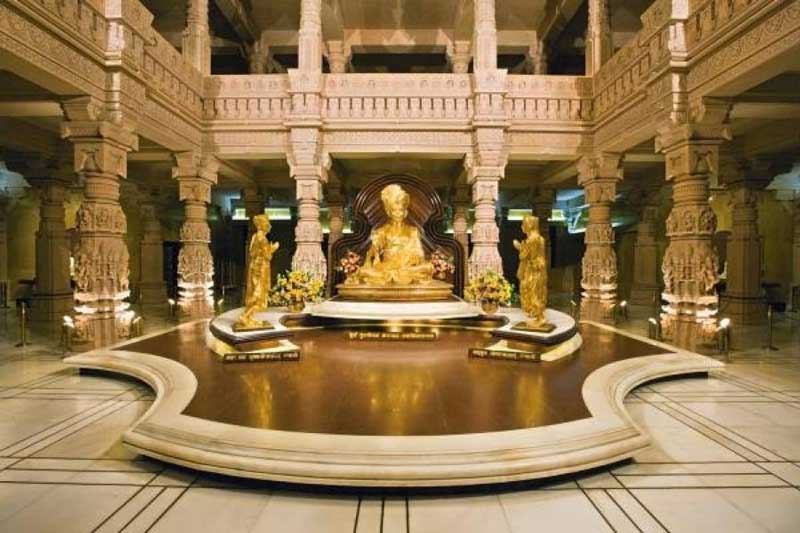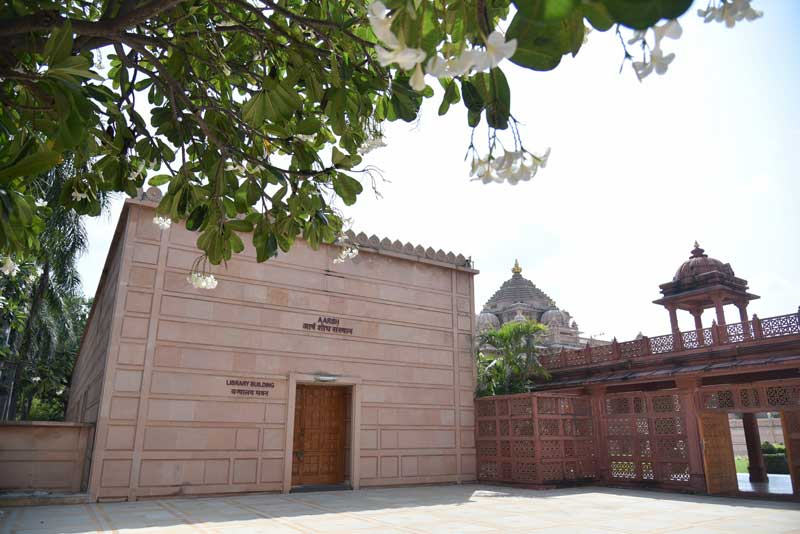
Located in Sector 20 of Gandhinagar, the capital city of Gujarat, the majestic, intricately carved stone structure of the Swaminarayan Akshardham that stands in the centre of a huge garden complex, sprawling around an area of 23-acre (9.30777 hectares), is considered one of the biggest Hindu temples in India and a major pilgrim destination. Inaugurated on 30 October 1992, and built from 6,000 metric tons of pink sandstone from Rajasthan, the temple is dedicated to Lord Swaminarayan and was built by Bochasanwasi Akshar Purushottam Swaminarayan Sanstha (BAPS), a Hindu denomination rooted in the Swaminarayan Sampraday, which features the worship of God, as the Purushottam and his choicest devotee, Akshar. Formed in 1905 by Shastri Yagnapurushdas, BAPS is centred on the doctrine of worshipping Akshar-Purushottam, which believes that Swaminarayan is an avatar of Purushottam Narayana, an incarnation of Vishnu. The sect believes it as a comprehensive path to ultimate liberation from the circle of life and death or moksha, through dharma or religion, bhakti or devotion, gnan or wisdom or awareness gained through experience, and vairagya, which can be translated as detachment from the earthly attractions. Today there are more than 1300 Swaminarayan temples and several educational centres, spread across five continents, facilitating the implementation of the doctrine, fostering culture and youth development.

Built over a long period of 13 years as a tribute to Swaminarayan, and reflecting the amazing architectural skills of the artisans, Akshardham Temple in Gandhinagar gracefully rises to an amazing height of 108 feet and extends to 131 feet in width and 240 feet in length. Embellished with 17 attractive domes, it is the focal point of the huge temple complex, featuring 97 intricately carved pillars, 57 window grills, 8 ornate balconies, 220 stone beams, and 264 aesthetically sculpted figures. Interestingly, as the temple is built in accordance with Vedic architectural principles, no traditional strong metal, like steel or iron, has been used in its structure, and in place of that, 210 single piece stone beams, each 20-feet long and weighing 5 tons have been used as load-bearing support of the temple.

The fascinating two-storey building of the temple is ringed by a Parikrama, also known as Pradakshina, a pathway surrounding the temple containing 365 stone pillars, meant for the pilgrims to circle the temple, while the entrance of the temple contains the holy footprints of Swaminarayan carved on marble with 16 sacred signs of God. Inside the temple, all the corners are sprinkled with statues of the succeeding Swaminarayan, and the sanctum sanctorum, popularly known as Garbhagriha, houses a seven-feet-tall, gold-leafed image of Swaminarayan. The idol, weighing 1.2 tons, and resting upon a three-feet pedestal, displays his right hand raised in the form of Abhay Mudra, symbolising reassurance and safety or dispelling of fear. The idol is flanked by his two main disciples, Aksharbrahma Gunatitanand Swami on his right and Aksharmukta Goplanand Swami on his left, both in postures of loving devotion toward Swaminarayan. Apart from that, it also houses images of several other successors of Swaminarayan, including Bhagatji Maharaj, Shastriji Maharaj, Pramukh Swami Maharaj, Yogiji Maharaj, and Mahant Swami Maharaj. In addition to that, the temple also features the idols of several Hindu deities like Lord Vishnu and his consort Lakshmi, Lord Krishna with Radha, Lord Rama with his consort Sita and their ardent devotee Hanuman, along with Lord Shiva with his consort Parvati and son Lord Ganesha. The basement of the temple, called the Prasadi Mandapam, displays a historical collection of various sacred relics and objects associated with Swaminarayan, such as his footwear, a bullock cart that he used for travelling, and his holy remains.

Apart from the main temple, the sprawling complex of the temple houses the newly added Abhishek Mandapam, inaugurated on 14 December 2015, where the Hindu ritual of Abhishek, which can be translated as coronation, of the idol of Neelkanth Varni, a yogic form of Swaminarayan, is performed when the deity is bathed with water and other specific items, associated with the chanting of sacred Sanskrit shlokas, devoted to the deity. In addition to that, the complex contains five exhibition halls, equipped with audio-visual system, which include the Neelkanth and Sahajannd Halls, which are devoted to depict the life, work and teachings of Swaminarayan, while the Mystic India Hall regularly screens a 40-minute film, directed by Keith Melton and narrated by Peter O’Toole, detailing the country wide spiritual journey of Swaminarayan. The fourth hall, named Premanand Hall, has three sections, of which the first one is devoted to the ancient Hindu texts like the Upanishads, Ramayana, and Mahabharata, while the second features photographic displays with explanations of the various symbols, scriptures, moral codes, and prayers associated with the major religious faith of the world, and the third serves as a tribute to some of the most famous poets of India. The fifth exhibition hall, Sant Param Hitakari, is a 15-minute animated show that depicts a spiritual assembly from the early 19th century, highlighting the core ideals of Sanatan Hindu Dharma.

In addition to the above, the huge complex also houses the Akshardham Centre for Applied Research in Social Harmony (AARSH), a futuristic research centre, associated with BAPS. Inaugurated in November 1992, the centre, containing an extensive library with a comprehensive collection of books and archives, serves as a hub for applied research aimed at fostering social harmony.

One of the popular attractions of the complex area is the Sat-Chit-Anand Water Show, a fascinating enactment of the story of Nachiketa and Yama, the god of death, as depicted in the Sanskrit text, the Katha Upanishad. The 45-minute vibrant show, using an 80ft wide and 60ft high water screen, multi-coloured lasers, video and light projections, fireballs, underwater illusion of fire, fountain and waterfall animations, water jets, along with a surround sound orchestra, is an enriching experience for the viewers.. Another popular attraction in the complex is the Sahajanand Van, an expansive 15-acre garden, containing several interesting parts, which include the rock arrangements, decorated with a number of statues and sculptures, fountains, and an artificial waterfall, together with a plant nursery, measuring 18,000 square feet. The Sahajanand Van is also equipped with an open-air theatre with a seating accommodation for 9,000 persons for cultural functions and festivals, along with Premvati, a vegetarian restaurant named, serving Indian cuisine with regional choices to the visitors.

On 24 September 2002, two armed terrorists attacked the Akshardham, opened indiscriminate firing, and killed 33 people, and wounding 70, when the National Security Guard Task Force was immediately mobilised from Delhi by air. But as the terrorists kept on shifting from one place to another, they could not be cornered before midnight. Finally, on the early morning of 25 September 2002, Subedar Suresh Chand Yadav in a daring act managed to close in with one of the terrorists and killed him in a close battle, but lost his life. Thereafter, the second terrorist was shot down by another squad. After the incident, a prayer assembly for the departed souls was arranged on 29 September, attended by 30,000 people, including the members of the bereaved family.